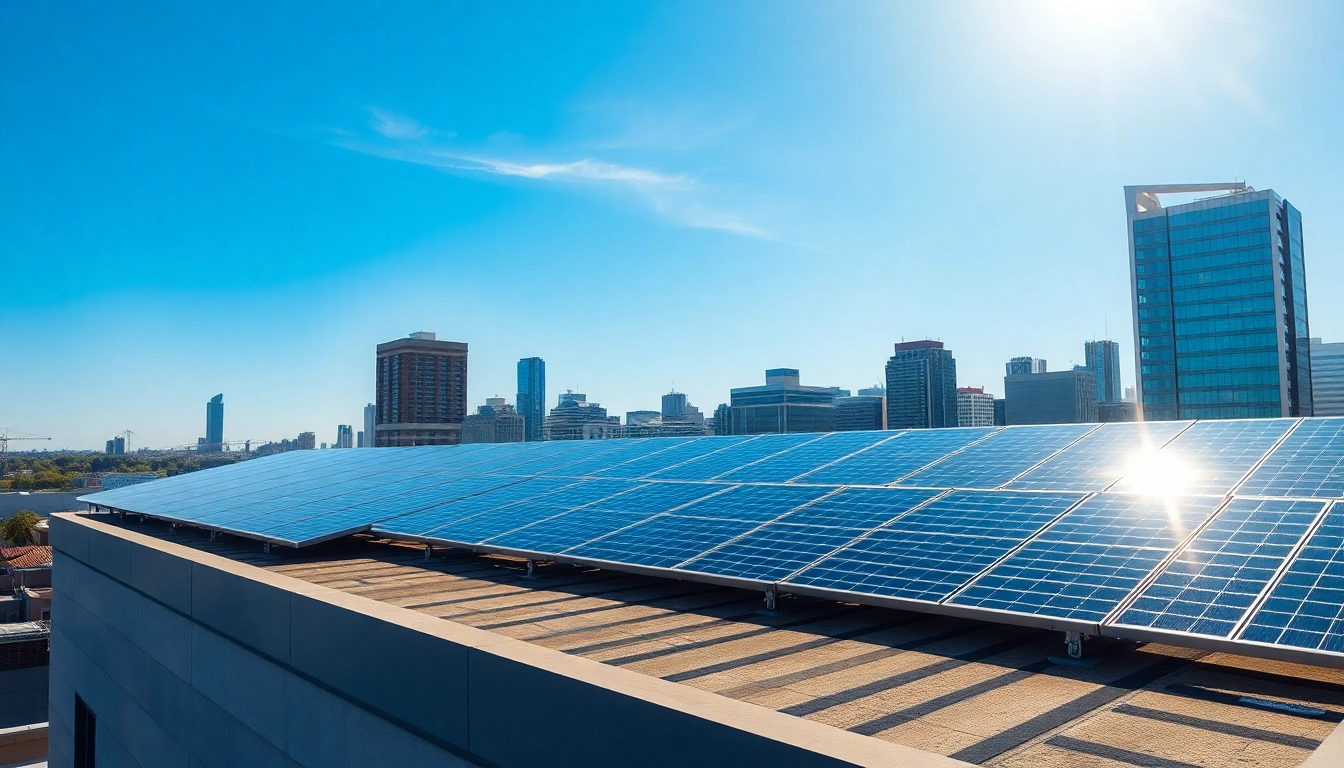Understanding Commercial Solar: Introduction to Solutions
As businesses continue to explore ways to reduce operational costs and improve their sustainability profiles, the adoption of commercial solar energy solutions has surged. This shift toward renewable energy not only supports environmental goals but also presents significant financial benefits. In this comprehensive guide, we will delve into what defines commercial solar systems, their various types, and the numerous advantages of making this energy transition.
What Defines Commercial Solar Systems?
Commercial solar systems are specifically designed to meet the energy demands of businesses rather than individual households. These systems can encompass a wide range of sizes,from small rooftop solar panels installed on office buildings to large-scale solar arrays that supply major energy requirements for manufacturing plants or commercial facilities. The defining aspects of commercial solar systems include:
- Scale: Typically, commercial solar systems range from tens of kilowatts to several megawatts, depending on the energy needs of the business.
- Ownership: These systems are primarily owned and operated by commercial entities, unlike residential solar systems which are owned by homeowners.
- Financing Options: Businesses have access to various financing models like Power Purchase Agreements (PPAs), Solar Leases, and tax incentives aimed specifically at commercial installations.
Types of Commercial Solar Installations
Understanding the different types of commercial solar installations is crucial for businesses considering a transition to solar energy. Here are the most common types:
- Rooftop Solar Systems: These installations are placed on the rooftops of commercial buildings, making efficient use of underutilized space.
- Ground-Mounted Solar Panels: Ideal for businesses with ample land, these systems can be installed in fields or large parking lots, maximizing energy generation potential.
- Solar Carports: These structures not only generate solar power but also protect vehicles from the elements, providing dual benefits to businesses.
- Community Solar Projects: These allow multiple businesses or residents to invest in a single solar farm, making solar energy more accessible to those with space constraints.
Key Benefits of Adopting Commercial Solar
Investing in commercial solar energy can yield numerous advantages for businesses, including:
- Reduced Energy Costs: By generating their own electricity, companies can drastically cut down their utility bills.
- Tax Incentives: Governments often provide significant tax credits, depreciation benefits, and other incentives that reduce the overall cost of solar installations.
- Enhanced Corporate Image: Utilizing renewable energy showcases a commitment to sustainability, enhancing a company’s reputation among consumers and stakeholders.
- Energy Independence: With solar power, businesses can protect themselves from rising energy rates and fluctuations in the energy market.
Evaluating the Cost of Commercial Solar Projects
Understanding the financial landscape of commercial solar projects is essential for businesses considering this transition. The initial investment and long-term savings must be analyzed thoroughly to ensure a successful implementation.
Initial Investment vs. Long-Term Savings
The upfront cost of commercial solar installations can vary significantly depending on various factors such as system size, technology, and installation specifics. Generally, businesses can expect to invest between $140,000 and $500,000 for a commercial solar system. However, while this initial outlay may seem high, the long-term savings typically offset these costs. By analyzing energy consumption patterns, businesses can estimate their potential savings on electricity bills, often realizing a return on investment within five to seven years.
Factors Influencing Commercial Solar Costs
Several key factors play a role in influencing the overall cost of commercial solar systems:
- System Size: Larger systems, while more expensive upfront, may offer a lower cost per watt due to economies of scale.
- Geographic Location: Installation costs can vary by region based on factors such as local labor rates, solar insolation, and permitting processes.
- Technology Type: Solar technology choices (like monocrystalline vs. polycrystalline panels) can impact both upfront and maintenance costs.
- Incentives and Rebates: Local and federal incentives can significantly reduce costs; hence, understanding available financial support is crucial.
Financing Options for Businesses
Businesses can leverage various financing options to make solar energy more accessible:
- Cash Purchase: The most straightforward option; businesses pay the total system cost upfront.
- Power Purchase Agreements (PPAs): A PPA allows businesses to install solar without upfront costs, paying only for the energy produced by the system.
- Solar Leases: Similar to PPAs, leases allow businesses to make monthly payments for the solar system while reaping the benefits of solar energy.
- Commercial Solar Loans: Traditional financing methods that allow businesses to finance solar installations through loans.
Choosing the Right Commercial Solar Provider
Selecting a reputable solar installation company is a critical step in ensuring a successful solar project. Several factors should be considered during this selection process.
What to Look for in a Solar Installation Company
When evaluating potential solar providers, consider the following:
- Experience and Credentials: Look for companies with a solid track record and certifications that ensure quality workmanship.
- Customer Service: A responsive and knowledgeable customer support team can significantly enhance the project experience.
- Complete Offerings: Choose providers that offer comprehensive solutions, including consultation, design, installation, and maintenance.
- Financial Transparency: Ensure the company is upfront about costs, timelines, and contractual obligations.
Understanding Contracts and Agreements
Carefully reviewing contracts and agreements is paramount. Key elements to consider include:
- Terms of Payment: Understand the payment structure and any potential penalties.
- Warranties: Ensure warranties on the system components, installation, and performance are clearly defined.
- Permitting Responsibilities: Determine who is responsible for securing necessary permits and licenses.
Customer Testimonials and Case Studies
Research previous projects completed by the solar provider to gauge their expertise and reliability. Look for:
- Case Studies: Detailed breakdowns of previous installations can illustrate a provider’s ability to deliver successful projects.
- Client Testimonials: Reviews from other businesses can provide insight into the company’s reputation and customer service.
Integrating Commercial Solar into Business Operations
To maximize the benefits of a solar installation, businesses need to strategically integrate solar energy into their operations. Understanding energy needs and creating a sustainable plan are key steps.
How to Assess Your Energy Needs
Analyzing a business’s energy needs is vital in designing an effective solar solution. Consider the following:
- Historical Energy Usage: Evaluate utility bills over the past few years to establish a baseline of energy consumption.
- Peak Demand: Identify times during the day or year when energy demands are highest.
- Future Energy Plans: Account for expected growth or operational changes that might alter energy needs in the future.
Creating a Sustainable Energy Plan
Developing a sustainable energy plan requires a comprehensive approach. Key components include:
- Energy Efficiency Measures: Implementing energy efficiency upgrades can further optimize energy consumption.
- Backup Solutions: Consider integrating storage solutions or backup generators to enhance energy reliability.
- Monitoring and Adjustment: Establishing monitoring systems can help track energy produced and consumed, allowing for adjustments as necessary.
Maintenance of Commercial Solar Systems
Regular maintenance is essential for ensuring the longevity and efficiency of commercial solar systems. Key maintenance tasks include:
- Regular Inspections: Regularly checking the system for dirt buildup and structural damage can prevent larger issues.
- Performance Monitoring: Employing monitoring software can offer insights into energy production levels and flag potential problems.
- Professional Servicing: Engaging with professionals for periodic maintenance can ensure that the system operates at peak performance.
Future Trends in Commercial Solar Technology
The commercial solar industry is rapidly evolving with new technologies and practices setting the stage for future developments. Being aware of these trends can guide businesses in their energy strategy.
Emerging Technologies and Innovations
Innovation in solar technology is continually advancing and can enhance the efficiency and performance of commercial solar systems:
- Smart Solar Panels: These panels are equipped with IoT sensors that provide real-time data and analytics.
- Building-Integrated Photovoltaics (BIPV): BIPV systems seamlessly integrate solar technology into building materials, allowing for more aesthetic and space-saving installations.
- Advanced Energy Storage Solutions: Innovations in battery technology are allowing businesses to store energy more efficiently, improving energy independence.
Regulatory Changes and Their Impact
The regulatory environment surrounding solar energy is constantly evolving. Businesses should stay informed about changes in legislation that might affect their solar investments:
- Federal and State Incentives: Understanding new incentives or revisited tax credits can benefit cost management.
- Renewable Energy Policies: Changes in renewable energy mandates may open additional markets for commercial solar investment.
- Grid Regulations: Be aware of changing regulations regarding how businesses can interact with the electricity grid.
Sustainability Goals and Corporate Responsibility
More than just a financial decision, adopting solar energy supports broader sustainability initiatives. Businesses are increasingly held accountable to:
- Environmental Impact Reports: Stakeholders expect transparency in how companies address environmental concerns.
- Corporate Social Responsibility (CSR): Integrating solar energy aligns with CSR goals by reducing carbon footprints and promoting renewable energy.
- Stakeholder Engagement: Engaging stakeholders about sustainability efforts can enhance brand image and market positioning.



